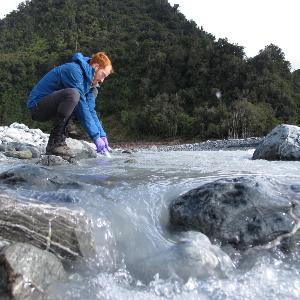Effects of mountain building on climate
22 Feb 2024
Aaron Bufe investigates how weathering and erosion affect Earth’s carbon budget over millions of years.
22 Feb 2024
Aaron Bufe investigates how weathering and erosion affect Earth’s carbon budget over millions of years.

Professor Aaron Bufe investigates processes that shape Earth’s surface. | © Foto-Studio Plaschka, Sabine Plaschka-Büscher
The surface of the Earth moves over million-year timescales. Driven by forces in the planet’s interior, mountain ranges are formed and then worn down again by weathering and erosion. The creation and slow destruction of mountains affects Earth’s carbon cycle. What this does to the climate is one of the questions that geologist Aaron Bufe is trying to answer.
“Around 30 years ago, a hypothesis emerged that mountain building over the past 50 million years from the Himalayas to the Alps contributed to cooling the climate. This hypothesis caused quite a stir in the community. Recent research, however, shows a more complex picture,” explains Bufe, who has been Professor of Sedimentology at LMU’s Department of Earth and Environmental Sciences since April 2023. His research interests are not limited to sedimentary rocks – solidified deposits of loose sediments – but encompass all processes that shape Earth’s surface.
Wind and weather gnaw at mountains, and erosion exposes fresh rock. The chemical weathering of these rocks affects the carbon cycle, but the effect depends on the type of rock. In the case of siliceous rocks, carbon dioxide is removed from the atmosphere. However, if rocks contain sulfur-bearing minerals, CO2 can be released – increasing the CO2 concentration in the atmosphere and contributing to global warming.
Bufe has investigated which of these processes dominates in various places, including the mountains of Taiwan, a landscape that particularly fascinates him: “These mountains are so active and are growing so fast; we don’t have such a landscape in Europe. The slopes are very steep and there are massive landslides and rockfalls. In 2009, for example, a typhoon triggered landslides that filled entire valleys with sediments.” For Bufe, these strong dynamics make Taiwan an exciting open-air laboratory, where he demonstrated that erosion plays a role in weathering.

Sampling of river water. | © J. Hemingway
The processes he studies play out on geologic timescales, emphasizes Bufe, and his data can help refine carbon cycle models. Natural rock-weathering has only limited bearing on the ongoing global climate change, because human CO2 emissions are orders of magnitude greater than the rates of atmospheric CO2 removal by silicate weathering. “If we were to completely stop all anthropogenic CO2 emissions, weathering would probably cause CO2 to be slowly removed from the atmosphere. However, it would take several hundreds of thousands of years before we would reach pre-industrial CO2 levels. Whether we could artificially enhance weathering – for example, by distributing finely ground rocks on fields – is hotly debated.”
Bufe’s scientific career began at the University of Cambridge, where he studied natural sciences. “In the beginning, you choose four separate subjects and specialize later. Within the first half of a year, I realized that geology was most fascinating to me,” says Bufe. During his doctorate at the University of California, Santa Barbara, he got particularly interested in surface processes. Following his return to Germany, he pursued this interest at the German Research Centre for Geosciences, where he worked for six years before coming to LMU.
The story is far from completeAaron Bufe
Bufe is particularly impressed by the scientific environment in Munich: “There are many opportunities at LMU. The strength of LMU in basic research and the integration of Earth and Environmental Sciences and Geography within the same faculty plays right into my interdisciplinary interests. In addition, we have the proximity to colleagues at the Technical University of Munich that often work on more applied topics. All this makes Munich a place with one of the most diverse groups of geoscientific experts, certainly in Germany and probably in Europe.”
There are many open questions that Bufe would like to explore at LMU. For example, he plans new studies in the largest river basin in the world, the Amazon. “To date, we know very little about the role of weathering outside of mountains,” says Bufe. Moreover, the effects of weathering in low-relief mountain ranges on the carbon cycle are poorly constrained. “The story is far from complete,” Bufe observes.